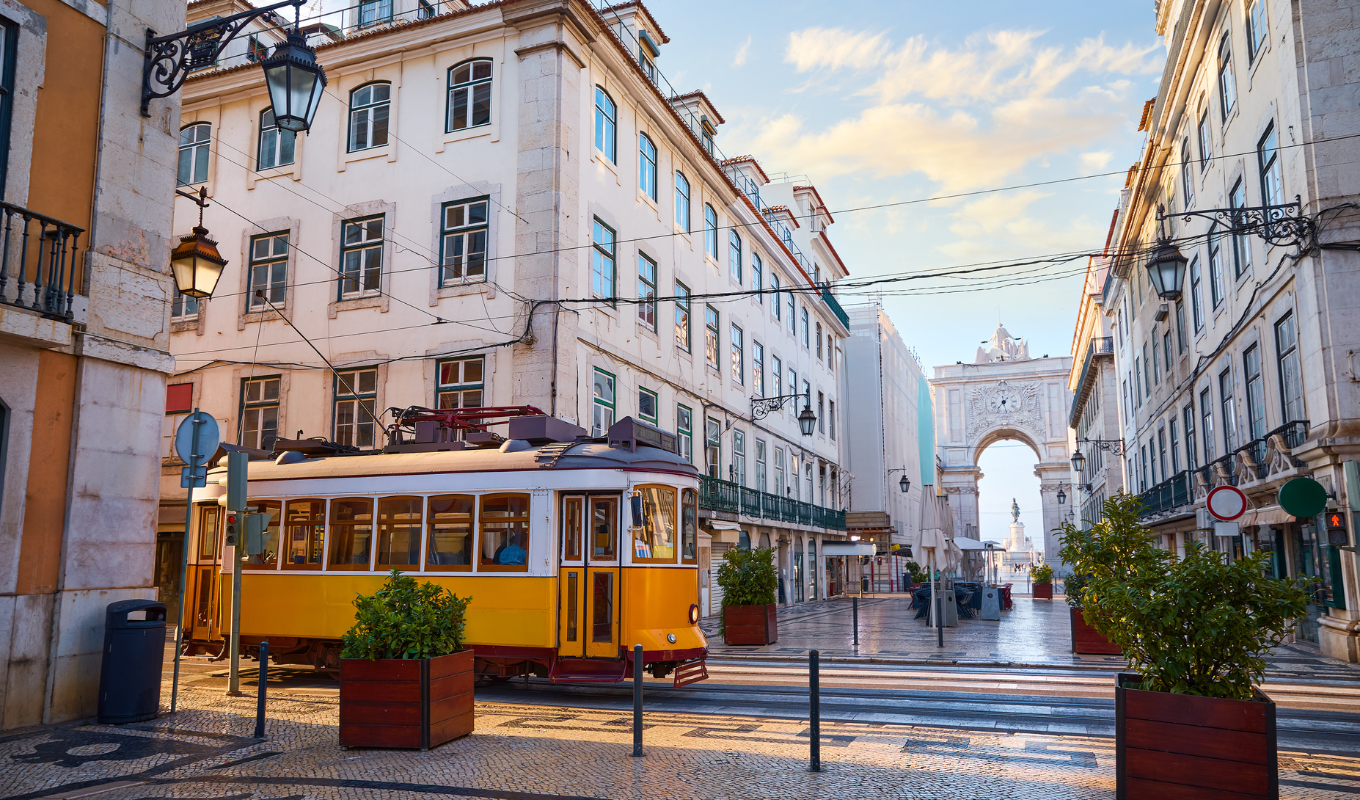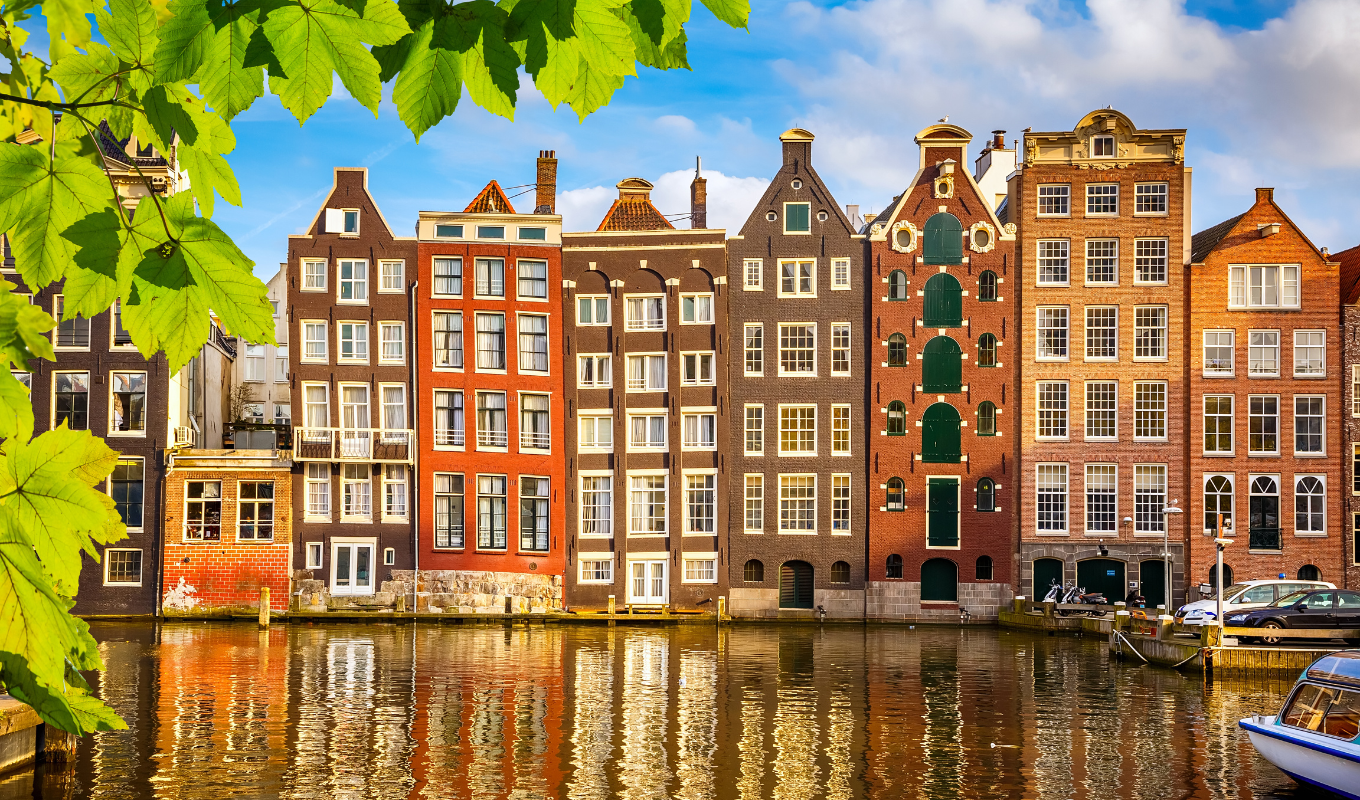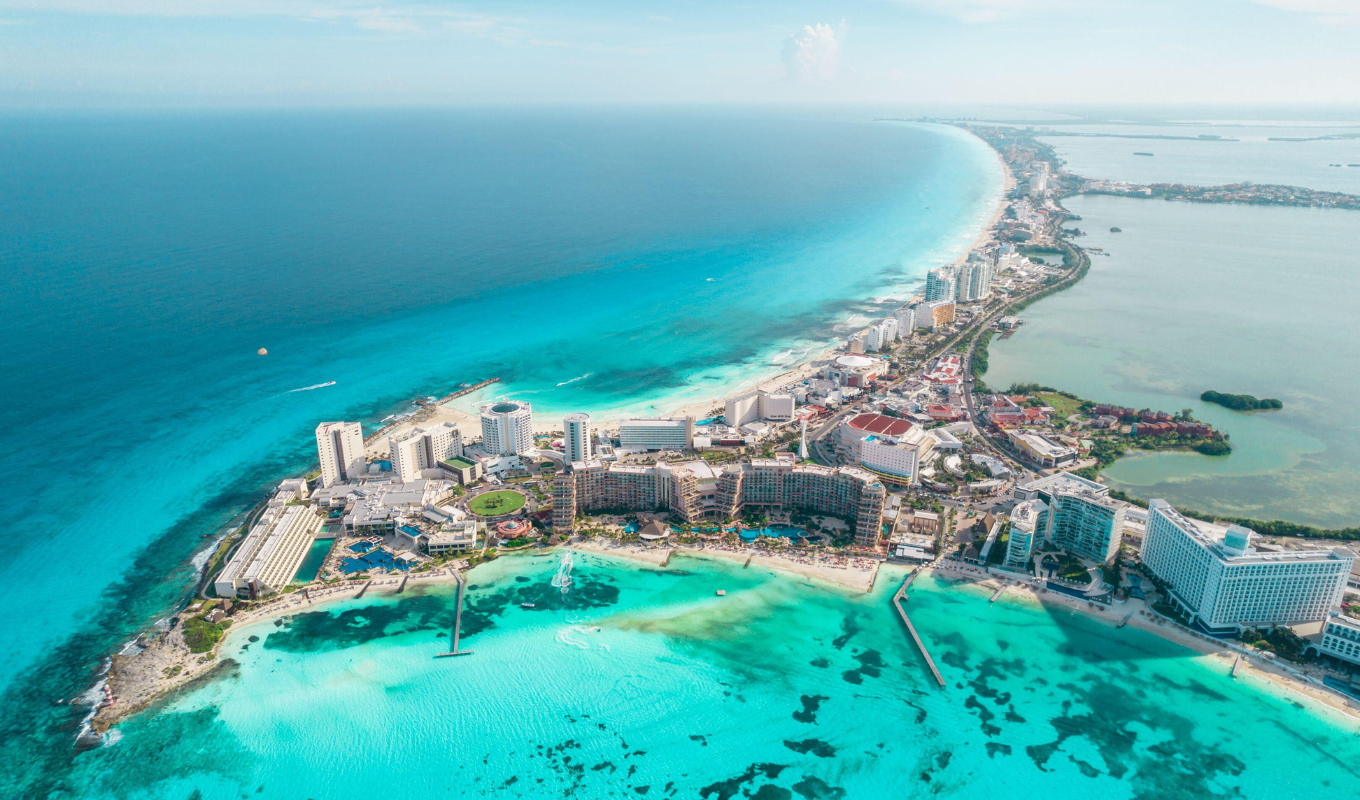Europe offers plenty of budget-friendly cities rich in history. From medieval towns to vibrant capitals, these destinations combine historical landmarks with low travel costs, making them perfect for American travelers. Here’s a quick rundown:
- Riga, Latvia: Affordable Art Nouveau architecture and medieval charm.
- Vilnius, Lithuania: Baroque beauty with low-cost food and lodging.
- Warsaw, Poland: Rebuilt Old Town with affordable dining and attractions.
- Kraków, Poland: Gothic and Renaissance landmarks at wallet-friendly prices.
- Gdańsk, Poland: Maritime history and compact, walkable Old Town.
- Lisbon, Portugal: Stunning views, UNESCO sites, and inexpensive public transport.
- Porto, Portugal: Port wine cellars and medieval streets on a budget.
- Zagreb, Croatia: Austro-Hungarian architecture and low daily expenses.
- Sighișoara, Romania: Medieval citadel and ties to Vlad the Impaler.
- Bratislava, Slovakia: Danube-side charm with low-cost stays and meals.
These destinations are easy to explore, affordable, and packed with history. Whether you’re into castles, cathedrals, or cobblestone streets, you’ll find plenty to enjoy without spending a fortune.
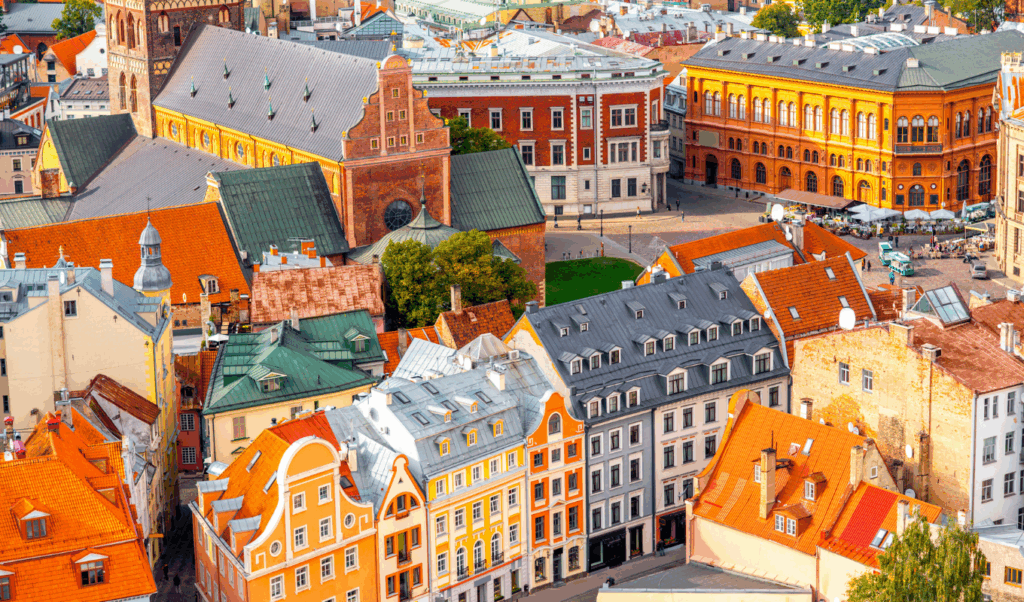
1. Riga, Latvia
Riga, the capital of Latvia, offers a medieval experience that’s both captivating and affordable. This Baltic treasure combines breathtaking architecture with budget-friendly options, making it a great destination for travelers eager to explore European history without breaking the bank.
Affordability
Riga is a fantastic destination for U.S. travelers seeking value. In Old Town, you can find accommodations to suit any budget, from hostels priced at $15–$25 per night to mid-range hotels ranging from $40–$70. These options place you right in the heart of the city, close to its most famous landmarks.
Dining is equally wallet-friendly. Casual meals cost around $4, while traditional Latvian dishes at local restaurants are typically under $15. Even upscale dining options rarely exceed $30. Getting around is simple and affordable too – most attractions are within walking distance, but if you need public transit, a single ticket costs about $1.20, with day passes available for roughly $4.50. Short taxi or ride-share rides generally stay under $10.
Historical Significance
Riga’s Historic Centre has been recognized as a UNESCO World Heritage Site since 1997, thanks to its impressive mix of Art Nouveau and medieval architecture. The city boasts the world’s largest collection of Art Nouveau buildings – over 800 in total.
The Old Town, or Vecrīga, is a living museum of history, with cobblestone streets and structures that date back to the 13th century. Despite enduring wars and occupations, this area has preserved its medieval character, offering visitors a glimpse into centuries past.
Key Attractions
One of Riga’s most famous landmarks is the House of the Blackheads, originally built in 1334 as a meeting place for unmarried merchants. Its Gothic and Baroque façade is a masterpiece, and the museum inside delves into Riga’s rich trading history.
The Riga Cathedral, founded in 1211, is the largest medieval church in the Baltic region. Its massive organ, with over 6,700 pipes, is a highlight, and visitors can climb the tower for stunning views of the Old Town.
The Three Brothers, a trio of historic residential buildings from the 15th to 17th centuries, offer another glimpse into Riga’s architectural past. Today, these buildings house the Museum of Architecture, where you can learn about the city’s construction traditions.
For panoramic views of Riga, head to St. Peter’s Church. An elevator ride to the observation deck costs about $6 and rewards visitors with 360° views of the city’s historic skyline.
Ease of Access for U.S. Travelers
Riga is not only affordable but also easy to reach. Riga International Airport connects to major European hubs, with U.S. travelers typically making one connection in cities like Amsterdam, Frankfurt, or Helsinki. Round-trip flights from the U.S. generally cost between $600 and $900, depending on the season and departure city.
For those looking to save even more, Dollar Flight Club frequently shares discounted flight deals to Baltic destinations, making Riga even more accessible for budget-conscious travelers.
The airport is located about 8 miles from the city center, and getting into town is simple. Options include buses ($1.20, about 30 minutes), taxis ($15–$20), or shared shuttles ($8 per person). With such convenience, Riga is an excellent choice for U.S. travelers wanting to immerse themselves in European history without overspending.
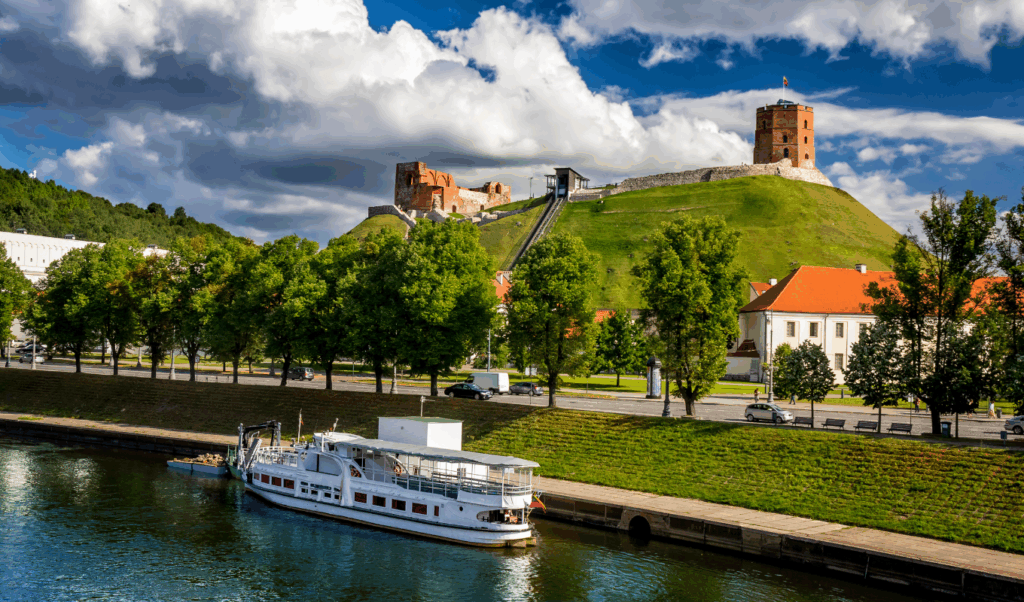
2. Vilnius, Lithuania
Vilnius, the capital of Lithuania, is a hidden treasure in Europe that offers U.S. travelers a chance to experience medieval history without breaking the bank. This charming Baltic city is known for its stunning baroque architecture and budget-friendly prices, making it an ideal destination for history lovers on a budget.
Affordability
For travelers watching their wallets, Vilnius offers unbeatable value. In the heart of its Old Town, you can find hostel beds for as little as $12–$20 per night, while mid-range hotels typically range from $35–$60. These options put you right in the middle of the city’s historic charm.
Dining is equally affordable. A filling meal at a local restaurant will set you back no more than $12, while street food options cost just $3–$6. Even high-end dining experiences are surprisingly affordable, often costing less than $25 per person. And if you’re a coffee enthusiast, you’ll love sipping on excellent espresso for under $2.
The Old Town is compact and easily walkable, but if you need to venture farther, public transportation is a steal. A single bus or trolley ticket costs about $1, while a day pass is just $3.50. Taxis within the city center are also reasonably priced, typically costing $5–$8.
While its affordability is a major draw, Vilnius also offers a rich tapestry of history.
Historical Significance
Vilnius is home to one of the largest surviving medieval old towns in Europe, recognized as a UNESCO World Heritage Site since 1994. Spanning over 890 acres, the historic center boasts more than 1,500 buildings showcasing Gothic, Renaissance, Baroque, and Classical architectural styles.
Historically, Vilnius was the capital of the Grand Duchy of Lithuania, which was one of medieval Europe’s largest states. Despite centuries of upheaval, the city has managed to preserve its architectural and cultural heritage, offering visitors a window into over 700 years of history.
Key Attractions
The city’s rich history is reflected in its iconic landmarks.
- Vilnius Cathedral and Bell Tower: Located in Cathedral Square, this neoclassical structure has been a spiritual hub since the 13th century. Inside, you’ll find royal tombs and the Chapel of St. Casimir, dedicated to Lithuania’s patron saint.
- Gediminas Tower: The last remnant of the Upper Castle from the 14th century, this hilltop tower features a museum highlighting Lithuanian history. The observation deck offers breathtaking views of the Old Town and costs about $4 to visit.
- Gate of Dawn: The only surviving gate from the original city wall, this 16th-century landmark houses a revered icon of the Virgin Mary. It’s both a pilgrimage site and an active place of worship.
- St. Anne’s Church: Renowned for its intricate brickwork, this Gothic masterpiece has remained virtually unchanged since the early 16th century.
- University of Vilnius: Founded in 1579, it’s one of Europe’s oldest universities. Visitors can explore its baroque and classical architecture through guided tours, which cost around $5.
Ease of Access for U.S. Travelers
Getting to Vilnius is straightforward, with Vilnius International Airport connecting to major European cities. U.S. travelers typically transfer through hubs like Frankfurt, Amsterdam, or Warsaw, with round-trip flights from the U.S. ranging from $650 to $1,000, depending on the season and departure city.
Once you land, the airport is just 4 miles from the city center. A bus ride downtown costs only $1 and takes about 20 minutes, while a taxi ride will cost $8–$12. Alternatively, trains are available for approximately $1.20, with a quick 15-minute journey to the central station.
For those seeking even more savings, discounted flight alerts from services like Dollar Flight Club can make Vilnius an even more appealing destination for U.S. travelers eager to explore European history without the hefty price tags of more tourist-heavy cities.
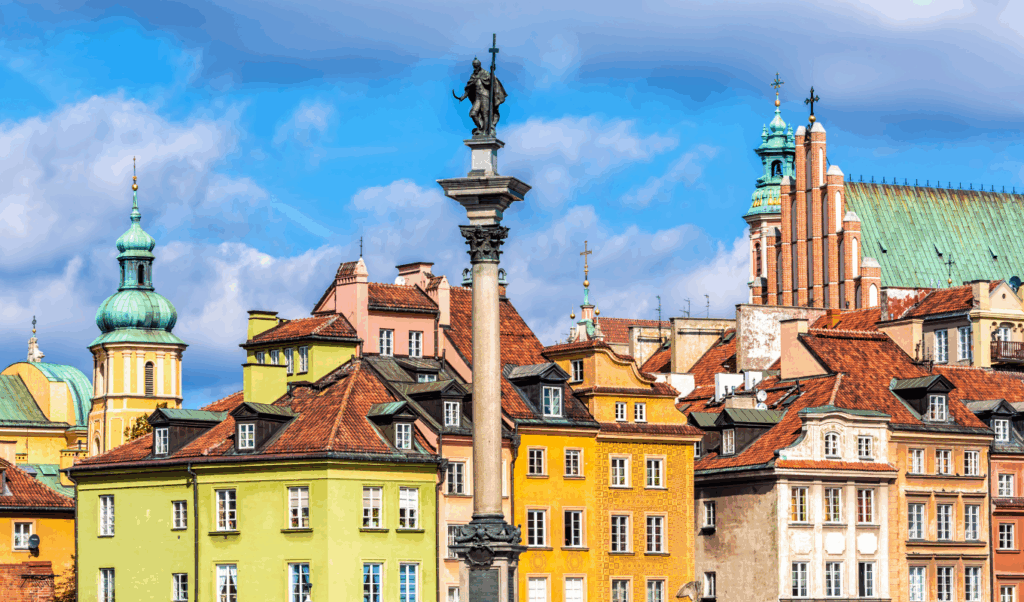
3. Warsaw, Poland
Warsaw stands as a symbol of resilience and an affordable gateway to European history. Nearly destroyed during World War II, Poland’s capital has transformed into a vibrant city where historic charm blends seamlessly with modern energy – all without breaking the bank.
Affordability
Warsaw is a haven for budget travelers. You can find hostel beds in the city center for just $15–$25 per night, while comfortable mid-range hotels typically cost $40–$70. Most accommodations are conveniently located near major attractions, making it easy to explore on foot.
Eating out in Warsaw is refreshingly inexpensive. A hearty Polish meal – think pierogi, kielbasa, or schnitzel – at a local restaurant costs about $8–$15. Craving a quick bite? Street food like zapiekanka (a Polish-style baguette pizza) or kebabs will only set you back $3–$5. Even upscale dining rarely exceeds $30 per person.
Getting around is equally wallet-friendly. Public transportation costs $1.20 per ride, or you can grab a day pass for $4.50. The city’s bike-sharing program, Veturilo, rents bikes for just $0.50 per hour. For short trips, taxis and ride-sharing services usually charge $6–$12 within the city center.
This affordability leaves plenty of room in your budget to dive into Warsaw’s rich history.
Historical Significance
Warsaw’s story is one of survival and rebirth. The meticulously reconstructed Old Town, recognized as a UNESCO World Heritage Site in 1980, is a testament to the city’s dedication to preserving its medieval roots while honoring its modern history.
The city played a key role during World War II. The Warsaw Ghetto Uprising in 1943 and the Warsaw Uprising in 1944 are pivotal moments in its history. After the war, Warsaw was painstakingly rebuilt using original architectural plans and historical artwork, making it a living museum of 20th-century European history.
These chapters of the past are brought to life through the city’s many landmarks and attractions.
Key Attractions
Warsaw’s attractions offer a deep dive into Polish culture and history, all at reasonable prices:
- Royal Castle: Once the residence of Polish royalty, this castle now houses a museum filled with royal apartments, art, and historical artifacts ($8 entry).
- Market Square: The heart of the Old Town, surrounded by colorful townhouses. It’s a lively spot with outdoor cafes, street performers, and weekend markets offering local foods and crafts.
- Warsaw Uprising Museum: This interactive museum tells the story of the 1944 uprising against Nazi occupation through artifacts and survivor testimonies ($7 entry).
- Łazienki Park: Known as the “Royal Baths Park”, this 188-acre green space features the stunning Palace on the Isle. The park is free to visit, with palace entry costing about $6. During summer, free Chopin concerts are held every Sunday.
- Palace of Culture and Science: A towering example of Soviet-era architecture, this building offers panoramic views of the city from its 30th-floor observation deck ($8 entry).
Ease of Access for U.S. Travelers
Warsaw Chopin Airport connects to major U.S. cities via European hubs like Frankfurt, Amsterdam, Paris, and London. Round-trip flights from the U.S. typically range from $600 to $1,100, depending on your departure city and the season. The airport is conveniently located just 6 miles from downtown Warsaw.
Getting to the city center is easy and affordable. Express trains to Central Station cost about $1.50 and take 20 minutes, while city buses are just $1.20 for a 30-minute ride. Taxis or ride-sharing services range from $15–$25. These budget-friendly options make Warsaw an accessible and economical destination for U.S. travelers.
For flight deals to Warsaw, check out Dollar Flight Club, which offers discounts of up to 90% on airfare.
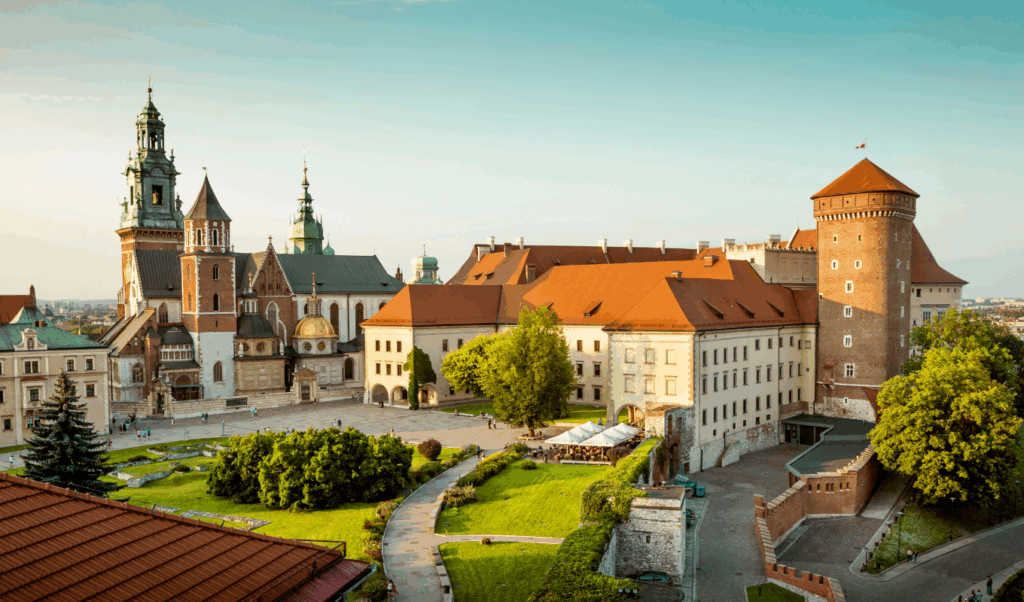
4. Kraków, Poland
Kraków combines medieval charm with wallet-friendly options, offering a mix of Gothic architecture, cobblestone streets, and deep-rooted traditions.
Affordability
For U.S. travelers, Kraków delivers excellent value, thanks to favorable exchange rates for the Polish złoty (PLN). Budget accommodations, like hostel dorms, range from $10 to $25 per night, while private rooms cost $25 to $35. Guesthouses fall between $20 and $50, mid-range hotels are priced at $35 to $90, and apartments start at about $40. Staying in neighborhoods like Kazimierz or Podgórze can help save even more while still enjoying the city’s authentic vibe. Visiting outside the peak summer months of July and August often results in better deals.
Daily food expenses are quite low, averaging $19 to $25. For instance, a meal at a milk bar – featuring pierogi, soup, and a drink – costs around $4.50. Street food, such as zapiekanka (a type of open-faced sandwich) and pierogi, can be even more affordable.
Most of Kraków’s attractions are within walking distance, which helps cut transportation costs. For longer trips, public transport passes are more economical than single tickets. Ride-hailing apps also provide transparent pricing for taxis. These affordable options leave more room in your budget to explore the city’s rich history.
Historical Significance
Kraków’s affordability is matched by its fascinating history. Known as Poland’s cultural center, the city boasts a 1,000-year legacy that comes to life in its UNESCO-listed Old Town, one of Europe’s best-preserved medieval layouts. Remarkably, Kraków emerged largely unscathed from World War II. Once Poland’s capital (from 1038 to 1596), it’s also home to Jagiellonian University, founded in 1364, where notable figures like Copernicus and Pope John Paul II studied.
Key Attractions
Kraków is packed with historical landmarks that showcase its rich heritage:
- Main Market Square (Rynek Główny): This massive square is the heart of the city, featuring the historic Cloth Hall (Sukiennice). Visitors can also climb St. Mary’s Basilica tower for sweeping views of the city.
- Wawel Castle and Cathedral: Overlooking the Vistula River, this former royal residence offers a glimpse into Poland’s regal past. The complex includes royal apartments, crown regalia, and an impressive art collection. Ticket prices depend on the exhibitions you choose to visit.
- Kazimierz District: Once a thriving Jewish quarter, Kazimierz provides a poignant look at pre-war Jewish life. The area is dotted with synagogues, some now serving as museums, and features numerous traditional eateries.
- Wieliczka Salt Mine: Located just outside the city, this UNESCO World Heritage Site showcases an underground world of salt-carved sculptures, chapels, and caverns. It’s a fascinating tribute to the region’s industrial history.
Ease of Access for U.S. Travelers
Kraków’s charm and affordability are complemented by its strong international connections. John Paul II International Airport Kraków-Balice is located conveniently close to the city center and offers flights to major U.S. cities through European hubs like Frankfurt, Amsterdam, Munich, and Vienna. Round-trip flights from the U.S. generally cost between $650 and $1,200, depending on your departure city and the season. Once you land, getting into the city is straightforward and budget-friendly, with options like express buses and trains.
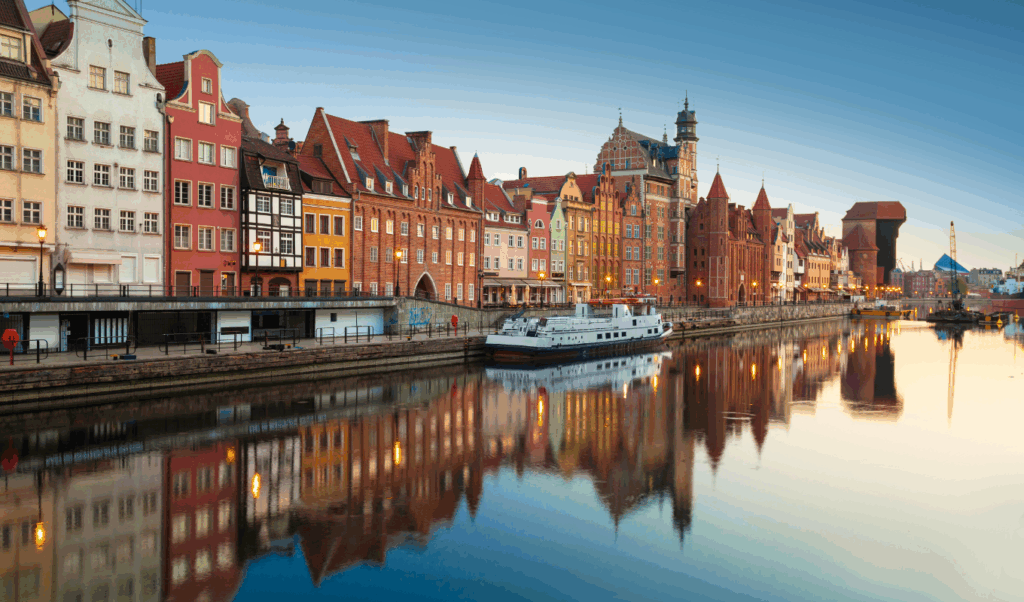
5. Gdańsk, Poland
Gdańsk is a treasure trove of history that also happens to be easy on the wallet. Its compact, pedestrian-friendly center means you can explore without worrying about hefty transportation costs.
Affordability
For American travelers, Gdańsk offers exceptional value. If you’re on a budget, you can expect to spend about $32 per day, while those seeking more comfort might average around $77 daily. Accommodations cater to all budgets, with hostel dorms costing around $12 per night (based on double occupancy) and mid-range hotels averaging $30 per night per person. During the low season, hotel rates hover around $45 per night, compared to $84 in peak periods.
Food is another area where your dollar stretches far. Daily dining costs average $39 per person, with meals priced between $4–$12 for breakfast, $6–$16 for lunch, and $12–$27 for dinner. Even a coffee break will only set you back about $3. Thanks to its compact layout, transportation costs are minimal, leaving you with more to spend on exploring the city’s fascinating history.
Historical Significance
Gdańsk’s history is as rich as its affordability. As a former Hanseatic League port, it was a major player in European maritime trade. It’s also famously known as the birthplace of the Solidarity movement in 1980, a peaceful resistance that played a key role in ending communist rule in Eastern Europe. The city’s shipyards became a global symbol of change. While much of its Gothic and Renaissance architecture was rebuilt after World War II, today’s Old Town is a beautifully restored glimpse into its medieval past.
Key Attractions
The city’s historical gems are conveniently concentrated in its walkable center. The Long Market (Długi Targ) is a must-see, lined with vibrant merchant houses that reflect Gdańsk’s prosperous maritime history. At its center, the Neptune Fountain, dating back to 1633, stands as an enduring emblem of the city.
St. Mary’s Church, one of the largest brick churches in the world, is another highlight. Its tower offers stunning panoramic views, and its interior can hold up to 25,000 people. For history buffs, the European Solidarity Centre provides an in-depth look at Gdańsk’s role in the peaceful revolution, while parts of the Gdańsk Shipyard are open for those interested in its industrial and political legacy.
Ease of Access for U.S. Travelers
Getting to Gdańsk is straightforward, thanks to Lech Wałęsa Airport. The airport connects to major European cities like Frankfurt, Amsterdam, and Warsaw, making it an easy layover stop. Round-trip flights from the U.S. typically range from $700 to $1,300, depending on your departure city and the season. Once you arrive, the airport is just 7 miles from the city center, with buses and taxis readily available to take you into town. Once you’re in Gdańsk, the city’s compact design makes it easy to explore most attractions on foot.
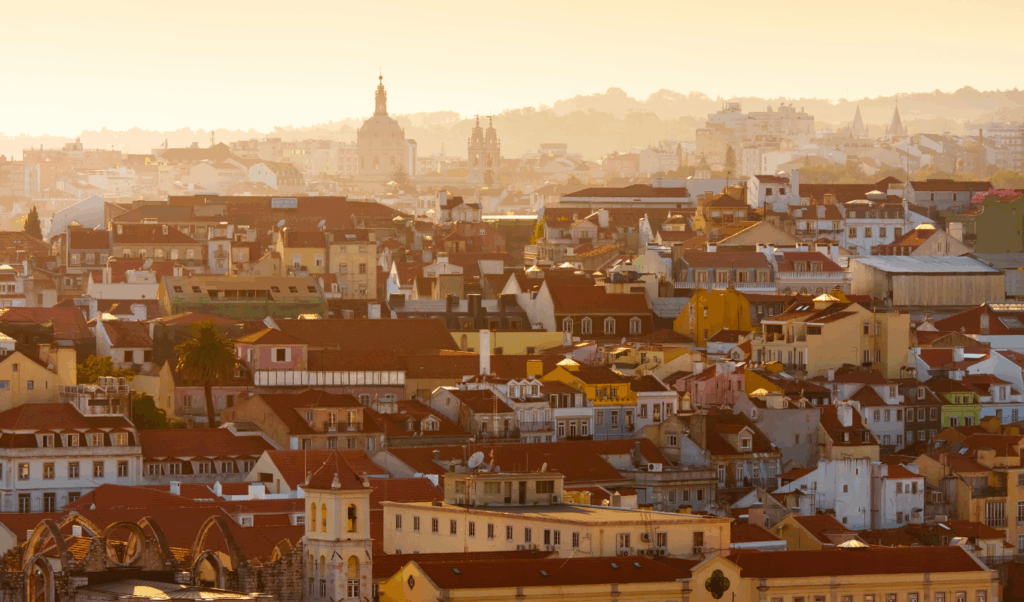
6. Lisbon, Portugal
Lisbon is a captivating mix of ancient history and affordability, making it a top pick for American travelers. With its seven hills dotted with vibrant neighborhoods, historic landmarks, and a warm Portuguese vibe, it offers a rich experience without breaking the bank.
Affordability
Lisbon delivers exceptional value for your money. If you’re traveling on a budget, you can get by on about $45–55 per day. For those who prefer more comfort, daily expenses typically range from $85–100. Accommodation is particularly wallet-friendly, with hostel beds starting at $15–20 per night and mid-range hotels averaging $40–60 per night for a double room.
Food in Lisbon is both delicious and affordable. A classic Portuguese breakfast with coffee and a pastel de nata costs just $3–5. Lunch at a traditional tasca (local tavern) ranges from $8–15, while dinner at a sit-down restaurant is around $15–25 per person. If you’re a wine lover, you’ll be pleased to know that a glass of excellent Portuguese wine is just $3–6. For an even cheaper bite, grab a bifana (pork sandwich) from a street vendor for only $2–3.
Getting around is easy on the wallet, too. A day pass for trams, buses, and the metro costs $6.40, and single rides are $1.50. The famous Tram 28, which connects many of Lisbon’s must-see spots, is included in this pass. While walking is the best way to explore the city, be prepared for some steep hills!
Thanks to its affordability, you can focus on diving into Lisbon’s rich history and cultural treasures.
Historical Significance
Lisbon’s history spans over 2,000 years, offering a fascinating journey from its Roman roots to its prominence as a maritime empire. During the Age of Discovery, explorers like Vasco da Gama set sail from Lisbon, opening trade routes to India and beyond. This golden era, from the 15th to 17th centuries, brought immense wealth, which funded the construction of stunning landmarks.
The Belém Tower and Jerónimos Monastery, both UNESCO World Heritage Sites, showcase Portugal’s maritime achievements and distinctive Manueline architecture. The monastery is also the final resting place of Vasco da Gama. Nearby, the Monument to the Discoveries honors the explorers who helped establish Portugal as a global power.
Lisbon’s Alfama district offers a glimpse into its Moorish past, with narrow, winding streets and traditional fado houses that have stood the test of time. Remarkably, this neighborhood survived the catastrophic 1755 earthquake, preserving a piece of medieval Lisbon for modern visitors to explore.
Key Attractions
Lisbon’s iconic landmarks are not only steeped in history but also conveniently located for budget-conscious travelers. Many of the city’s main attractions are in walkable areas, making it easy to explore without spending much.
Atop one of Lisbon’s hills, São Jorge Castle provides sweeping views of the city and insights into its history, from Roman times to the present. While the castle grounds are free to roam, entry to the interior costs $10.
In the Belém neighborhood, you’ll find more than just the UNESCO sites. The National Coach Museum houses an impressive collection of royal carriages, while the Belém Cultural Center features exhibitions of Portuguese art. Don’t miss the original Pastéis de Belém bakery, where the famous custard tarts have been made using a secret recipe since 1837.
Rossio Square and the surrounding Baixa district highlight Lisbon’s post-earthquake rebirth with elegant 18th-century architecture. The Santa Justa Elevator offers stunning city views, while the Chiado and Bairro Alto neighborhoods combine historic charm with lively nightlife. For a truly local experience, catch a traditional fado performance in one of the neighborhood taverns.
Ease of Access for U.S. Travelers
Getting to Lisbon is straightforward for travelers from the U.S., thanks to Humberto Delgado Airport. Direct flights are available from cities like New York, Boston, Miami, and San Francisco, with TAP Air Portugal operating most routes. Flights take about 6–9 hours, and the airport is conveniently located just 4 miles from downtown Lisbon.
Round-trip flights from the U.S. typically cost $500–900 during off-peak times, rising to $800–1,400 in the summer. For easy airport transfers, the AeroBus offers direct service to the city center for $2, while the metro’s red line connects to Lisbon’s main transit system for $1.50.
U.S. citizens can stay in Portugal for up to 90 days without a visa, as long as they have a valid passport. Keep an eye out for discounted flight alerts to make your trip even more affordable.
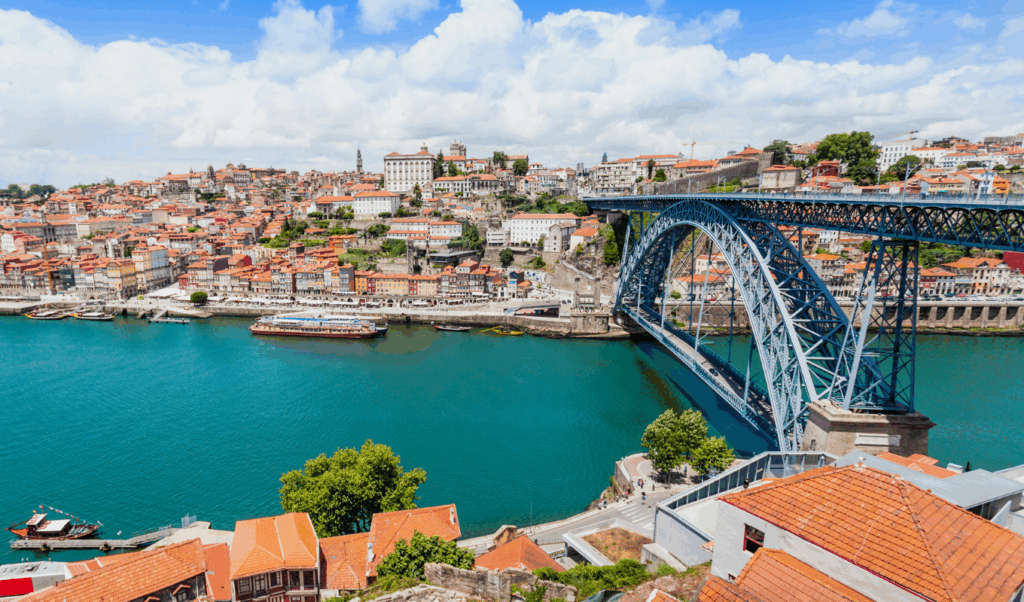
7. Porto, Portugal
Porto offers a charming mix of medieval history and budget-friendly travel options, making it an appealing destination for American travelers. Famous for its port wine cellars, striking azulejo tiles, and a UNESCO-recognized historic center, Porto delivers a rich Portuguese experience at a fraction of the cost of many Western European cities. It’s a place where old-world charm meets modern convenience.
Affordability
Porto is one of Europe’s most wallet-friendly cities, especially for those drawn to its historical allure. Daily expenses for budget travelers typically range from $35–$45, while those seeking more comfort can expect to spend $70–$90. Accommodations are equally affordable, with hostel beds starting at $12–$18 and mid-range hotels or guesthouses priced between $35–$55. Many of these are located in historic buildings, offering a unique and local vibe without breaking the bank.
The city’s food scene is both delicious and easy on the wallet. A traditional Portuguese breakfast of coffee and a fresh pastry costs just $2–$4, while the iconic francesinha sandwich – a hearty dish layered with meats, cheese, and a rich tomato-beer sauce – can be enjoyed for $6–$10 at local spots. Dinner at a traditional eatery typically costs $12–$20 per person, and a glass of port wine is a steal at $3–$5.
Transportation is another area where Porto shines in affordability. A day pass covering the metro, buses, and historic trams is just $4.15, and single rides cost around $1.20. The city is highly walkable, with many attractions clustered in the center. For a scenic ride, hop on Tram 1, which runs along the Douro River to the Atlantic and is included in the day pass.
Historical Significance
Porto’s history spans over two millennia, and its historic center earned UNESCO World Heritage status in 1996. The city played a vital role during Portugal’s Age of Discovery, thanks to its strategic location at the Douro River’s mouth, which made it a key hub for trade and exploration.
One of Porto’s standout landmarks is the Clérigos Tower, a baroque masterpiece built between 1735 and 1763. Standing 249 feet tall, it offers breathtaking views of the city’s red rooftops and the winding Douro River. The Ribeira district, with its narrow, cobblestone streets and medieval buildings dating back to the 12th century, provides a vivid glimpse into Porto’s storied past.
Porto is also the birthplace of port wine. The wine cellars in Vila Nova de Gaia have been crafting this world-famous fortified wine using traditional methods since the 17th century, making it a must-visit for wine lovers.
Key Attractions
Porto’s attractions combine historical depth with easy access. The Dom Luís I Bridge, completed in 1886, connects Porto with Vila Nova de Gaia and offers stunning views across its two levels – completely free to walk across.
The São Bento Railway Station is another highlight, featuring over 20,000 hand-painted azulejo tiles that illustrate scenes from Portuguese history. This working train station doubles as a cultural treasure, and you can admire it without any entrance fee.
For book and architecture enthusiasts, Livraria Lello is a must-see. Often called one of the world’s most beautiful bookstores, its neo-Gothic design, intricate wooden staircase, and stained-glass ceiling have been drawing visitors since 1906. Entry costs about $5, which can be redeemed toward a book purchase. Additionally, the Porto Cathedral offers free access to its main areas, while guided tours of the Palácio da Bolsa, including its dazzling Arabian Hall, are available for about $8.
Wine aficionados will enjoy tours and tastings at the port wine cellars in Vila Nova de Gaia, with experiences starting at $8–$15.
Ease of Access for U.S. Travelers
Porto’s accessibility adds to its appeal. Francisco Sá Carneiro Airport, located about 7 miles from the city center, serves as the primary gateway. While direct flights from the U.S. are limited, connecting flights through major European hubs like Madrid, Paris, or Frankfurt are convenient, with total travel times typically between 8–12 hours (layovers included).
Round-trip flights from the U.S. usually cost $600–$1,100 during off-peak seasons and $900–$1,500 in summer. TAP Air Portugal frequently offers competitive fares, and signing up for Dollar Flight Club can help you snag discounted deals.
Once you land, getting to the city center is both easy and affordable. Metro Line E takes you downtown in just 30 minutes for $1.60, while the AeroBus offers a similar service for about $2.
U.S. citizens can visit Portugal for up to 90 days without needing a visa, provided they have a valid passport. English is widely spoken in tourist areas, making navigation simple. With its blend of rich history, budget-friendly options, and convenient travel connections, Porto is an excellent choice for American travelers.
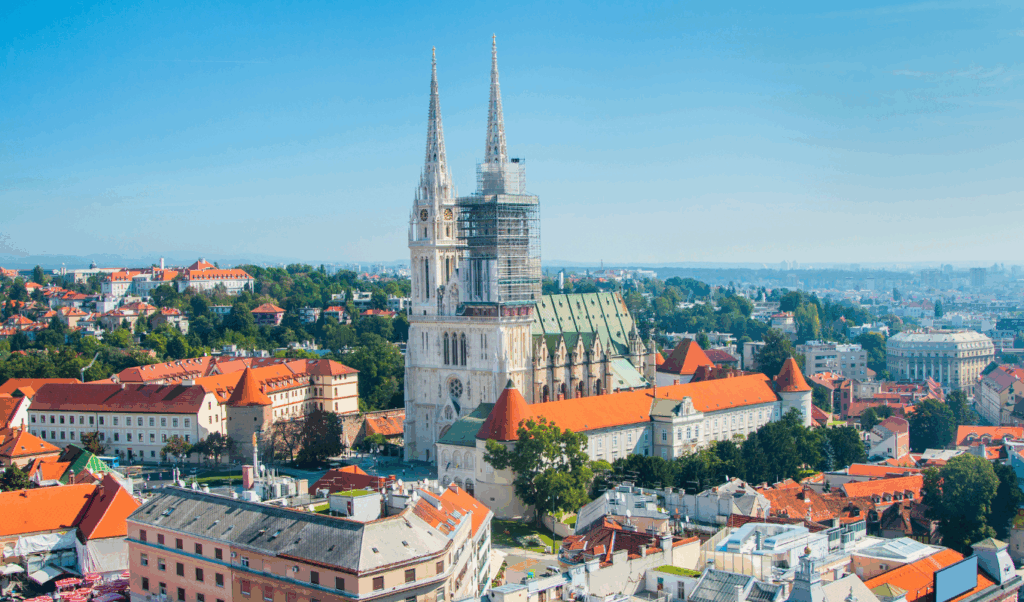
8. Zagreb, Croatia
Zagreb offers a charming mix of medieval history and wallet-friendly travel, making it an inviting destination for Americans seeking a European adventure. Croatia’s capital is a delightful combination of Austro-Hungarian architecture, age-old traditions, and prices that are far more reasonable than those in many Western European cities. With its compact historic center and lively cultural vibe, Zagreb delivers an authentic experience minus the throngs of tourists or hefty price tags. Let’s break down what makes this city such a fantastic budget-friendly option.
Affordability
Traveling in Zagreb is surprisingly economical. Budget-conscious visitors can get by on about $30–$40 a day, while those looking for a bit more comfort might spend $55–$75 daily. These figures typically include lodging, meals, transportation, and entry fees to attractions.
For accommodations, there are options for every budget. Hostel beds in the city center start at just $10–$15 per night. If you prefer mid-range hotels or boutique guesthouses, expect to pay $30–$50 per night, often with added perks like locally sourced breakfasts featuring fresh pastries and robust Croatian coffee.
Food is another area where Zagreb shines. A traditional Croatian breakfast of coffee and burek (a flaky pastry filled with cheese or meat) from a bakery costs about $2–$3. Lunch at a local eatery usually runs $5–$8, while a hearty dinner at a traditional konoba (tavern) costs around $10–$15 per person. Dishes like štrukli (cheese-filled pastry) and goulash are not only delicious but also easy on the wallet.
Getting around the city is both convenient and inexpensive. A daily pass for trams, buses, and the historic funicular is about $3.50, while single rides cost roughly $1.30. The city center itself is highly walkable, with most attractions within a 15-minute stroll. For a scenic ride, hop on the historic tram network, which has been running since 1891, connecting the Upper and Lower Towns.
Historical Significance
Zagreb’s history stretches back nearly a thousand years, originating from two medieval settlements, Gradec and Kaptol, which united in 1850 to form the modern city. The Upper Town (Gornji Grad) still retains its medieval allure with cobblestone streets and Gothic architecture dating to the 13th century.
The city played a significant role in Croatian national identity, particularly during the Croatian National Revival of the 19th century. The Illyrian movement, which championed South Slavic unity and cultural development, was rooted in Zagreb in the 1830s and 1840s.
St. Mark’s Church is one of Zagreb’s most iconic landmarks. Its colorful tiled roof, featuring the medieval coats of arms of Croatia, Dalmatia, and Slavonia, reflects over 700 years of history. Nearby, the Stone Gate serves as a shrine and pilgrimage site, thanks to a miraculous painting of the Virgin Mary that survived a fire in 1731.
Key Attractions
Zagreb’s landmarks beautifully showcase its rich history. The Zagreb Cathedral, with twin neo-Gothic spires towering at about 344 feet, dominates the city skyline. Entry to the main areas is free, and the cathedral houses the tomb of Cardinal Alojzije Stepinac, along with intricate stained glass windows and historic stone carvings.
For something a bit different, the Museum of Broken Relationships offers a quirky yet touching experience. Admission is about $7, and the museum features personal objects from past relationships, each paired with a story. Despite its international fame, the Zagreb location retains a distinctly local charm.
Dolac Market, affectionately known as the “Belly of Zagreb”, has been a bustling farmers’ market since 1930. Here, visitors can browse fresh produce, local cheeses, and handmade crafts while soaking in the lively atmosphere of everyday life.
The Upper Town is perfect for exploring on foot, with its preserved city walls, historic gates, and narrow streets. Walking tours, typically priced at $10–$15, are a great way to dive into the area’s history, though many visitors enjoy wandering on their own. For panoramic city views, climb the Lotrščak Tower for about $3 and stick around for the daily cannon firing at noon, a beloved local tradition.
Ease of Access for U.S. Travelers
Getting to Zagreb involves connecting through major European hubs. Franjo Tuđman Airport, located about 10 miles southeast of the city center, is the main entry point. Flights from the U.S. often connect through cities like Frankfurt, Munich, Vienna, or Amsterdam, with total travel times ranging from 10 to 14 hours.
Round-trip flights usually cost between $700–$1,200 during shoulder seasons and $1,000–$1,600 in peak summer months. Airlines like Croatia Airlines and Lufthansa frequently offer competitive options, and members of Dollar Flight Club can find exclusive deals to cut costs further.
Once you arrive, transportation is straightforward. The Croatia Airlines bus connects the airport to the main bus station in about 30 minutes for $4, while taxis to the city center cost $25–$35. Many hotels also provide shuttle services for added convenience.
U.S. citizens can visit Croatia visa-free for up to 90 days with a valid passport. English is widely spoken in tourist areas, making communication easy. Since Croatia joined the Eurozone in 2023, travelers can now use euros, eliminating the hassle of currency exchange.
While Croatia has gained fame for its scenic coastal cities, Zagreb remains refreshingly less crowded. Its combination of easy access, affordability, and rich history makes it an excellent choice for Americans looking for an authentic slice of Europe.
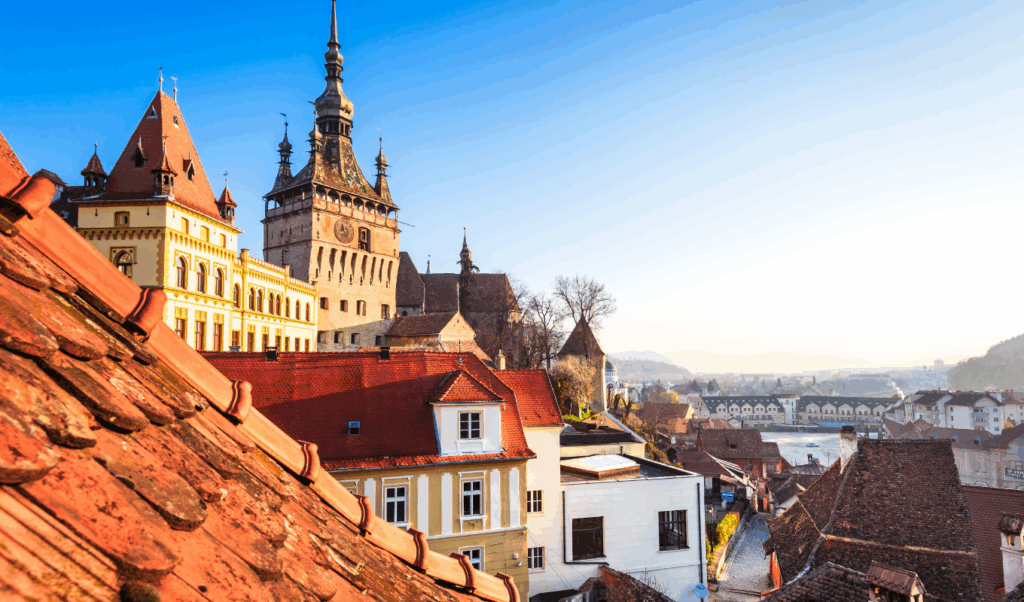
9. Sighișoara, Romania
Tucked away in the heart of Transylvania, Sighișoara stands as one of Europe’s most well-preserved medieval towns. Its cobblestone streets, ancient fortifications, and timeless charm make it a perfect destination for history lovers looking for a budget-friendly getaway.
Affordability
Traveling to Sighișoara won’t break the bank. The town offers a variety of accommodations, from budget-friendly hostels to cozy guesthouses. Dining is equally wallet-friendly, with local cafés and restaurants serving hearty meals at reasonable prices. Plus, the town’s compact layout means you can explore most attractions on foot or by using affordable local transportation.
Historical Significance
Sighișoara is a UNESCO World Heritage site with roots dating back to the 12th century, when it was founded by German craftsmen and merchants. Its fortified citadel, complete with original towers maintained by guilds, offers a glimpse into the vibrant medieval life that once thrived here. For those intrigued by legends, the town is famously linked to Vlad the Impaler, adding a touch of mystery to its historic charm. This blend of history and folklore is reflected in its many landmarks.
Key Attractions
- Clock Tower: A striking feature of the town’s skyline, the Clock Tower houses a museum and provides stunning panoramic views of the Transylvanian countryside.
- Vlad Dracul’s House: This historic building, now a restaurant and museum, is tied to the legend of Vlad the Impaler and showcases medieval architecture.
- Covered Staircase: A wooden, sheltered staircase leading to the Church on the Hill, offering both architectural beauty and sweeping views of the town.
- Rope Street: Known as one of Europe’s narrowest streets, this quirky passage highlights the efficient use of space in the medieval citadel.
- Torture Room Museum: Located beneath the Clock Tower, this small museum displays medieval punishment devices, giving visitors a peek into the darker side of history.
Ease of Access for U.S. Travelers
For U.S. visitors, reaching Sighișoara is straightforward. Flights into Romania typically connect through major cities like Bucharest or Cluj-Napoca. From there, affordable train rides or car rentals make the journey to Sighișoara simple. U.S. citizens don’t need a visa for stays under 90 days, and the Romanian leu’s favorable exchange rate ensures your dollars go further.
Despite its small size, Sighișoara has enough to keep visitors captivated for more than just a day. Many extend their stay to soak in the medieval atmosphere and explore nearby gems like Brașov, Sibiu, and the iconic Bran Castle. The town’s charm, combined with its affordability, makes it a must-visit destination for anyone seeking a journey back in time.
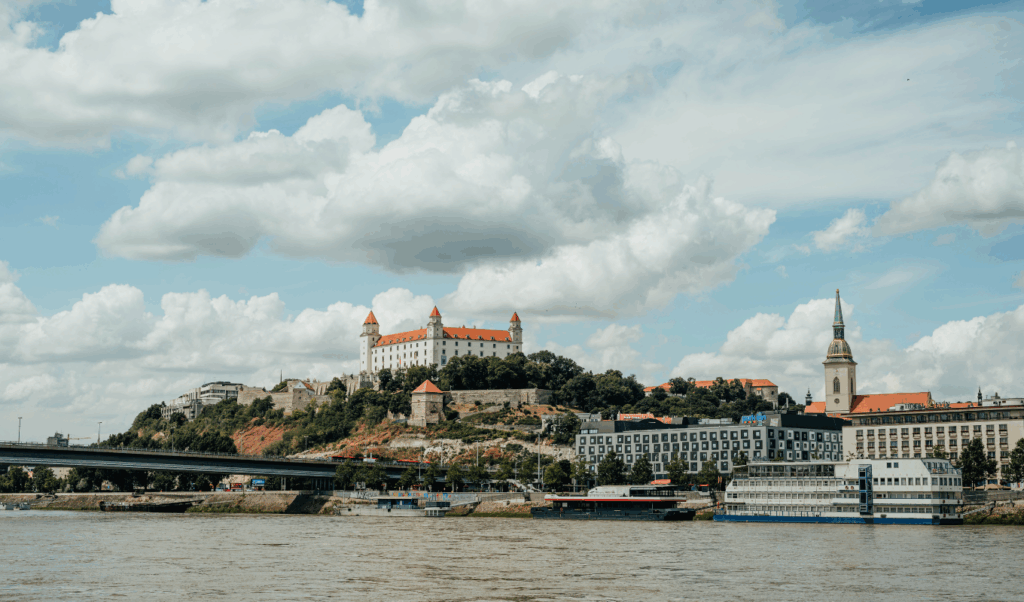
10. Bratislava, Slovakia
Bratislava, perched along the Danube River, offers a delightful mix of history and affordability. This compact capital is perfect for travelers looking to experience rich heritage without breaking the bank.
Affordability
On average, a day in Bratislava costs around $78. Here’s how it breaks down: hostel stays are about $23 per night, meals cost approximately $37 per day, and local transit adds up to $12. Compared to many Western European capitals, this makes Bratislava a wallet-friendly destination.
For even more savings, consider staying outside the city center and taking advantage of Bratislava’s efficient public transit system, which includes trams, buses, and trolleybuses. The Old Town is largely pedestrian-friendly, so you can explore many of its charming streets on foot.
Plan ahead to stretch your budget further. Booking accommodations early, eating at restaurants outside tourist-heavy areas, and traveling during the shoulder season can all help reduce costs. Carrying a reusable water bottle is another simple way to save on extras.
City Comparison Table
Here’s a quick snapshot of costs and historical highlights across several cities:
| City | Daily Budget | Hotel Cost (per night) | Meal Price Range | Key Historical Sites | UNESCO Status |
|---|---|---|---|---|---|
| Riga, Latvia | $65-85 | $35-60 | $8-25 | Art Nouveau District, Riga Castle, St. Peter’s Church | Yes (Historic Centre) |
| Vilnius, Lithuania | $70-90 | $40-65 | $10-28 | Vilnius Cathedral, Gediminas Tower, Old Town | Yes (Historic Centre) |
| Warsaw, Poland | $75-95 | $45-70 | $12-30 | Royal Castle, Old Town Market Square, Palace of Culture | Yes (Historic Centre) |
| Kraków, Poland | $80-100 | $50-75 | $15-35 | Wawel Castle, Main Market Square, Cloth Hall | Yes (Historic Centre) |
| Gdańsk, Poland | $70-90 | $40-65 | $12-28 | Neptune Fountain, St. Mary’s Church, European Solidarity Centre | No |
| Lisbon, Portugal | $85-110 | $55-80 | $18-40 | Belém Tower, Jerónimos Monastery, São Jorge Castle | Yes (Monastery of the Hieronymites) |
| Porto, Portugal | $75-95 | $45-70 | $15-32 | Ribeira District, Clérigos Tower, Port Wine Cellars | Yes (Historic Centre) |
| Zagreb, Croatia | $70-90 | $40-65 | $12-30 | St. Mark’s Church, Zagreb Cathedral, Upper Town | No |
| Sighișoara, Romania | $50-70 | $25-45 | $8-20 | Clock Tower, Vlad Dracula House, Medieval Citadel | Yes (Historic Centre) |
| Bratislava, Slovakia | $65-85 | $35-60 | $10-25 | Bratislava Castle, St. Martin’s Cathedral, Old Town | No |
Highlights and Insights
- Budget-Friendly Charm: Sighișoara stands out as the most affordable destination, offering a mix of low costs and medieval allure.
- Historical Richness: Lisbon, while pricier, delivers a wealth of historical landmarks, making it a top pick for history enthusiasts.
- Balanced Options: The Polish cities – Warsaw, Kraków, and Gdańsk – strike a balance between cost and historical significance, each with its unique flavor.
- Eastern-European Value: Riga and Vilnius shine as affordable Baltic capitals, both boasting UNESCO-protected old towns.
- Western Touch at a Lower Cost: Porto blends the charm of Western Europe with prices reminiscent of its Eastern counterparts.
This table and analysis highlight how each city offers a unique combination of affordability and historical appeal, catering to a variety of preferences and budgets.

Conclusion
Europe’s historical cities offer an incredible opportunity to explore the past without breaking the bank. From medieval towns to grand monuments, these destinations provide history lovers with a chance to experience rich heritage at a fraction of the cost.
Cities in Eastern Europe, such as Riga, Vilnius, and Poland’s charming trio – Kraków, Gdańsk, and Wrocław – stand out for their stunning architecture and unbeatable value. On the other hand, Western European spots like Porto and Lisbon deliver a mix of historical charm and modern comforts, often at much lower costs than their more famous neighbors. Together, these cities highlight how affordability and history can go hand in hand.
What sets these places apart is their genuine atmosphere. Picture yourself wandering through cobblestone streets, marveling at Gothic cathedrals, or stumbling upon quiet courtyards – all without the overwhelming crowds or hefty price tags. These cities offer a chance to immerse yourself in local culture while enjoying their historical landmarks.
Of course, airfare can be a significant expense, so keeping flight costs low is key to staying within budget. Tools like Dollar Flight Club can help you find discounted flights, leaving you with extra cash to spend on castle tours, local dishes, or other memorable experiences. Affordable accommodations and dining options across these cities further stretch your travel budget.
Whether you’re captivated by Kraków’s royal history, Gdańsk’s maritime legacy, or Sighișoara’s ties to Dracula, these destinations prove that exploring Europe’s fascinating stories doesn’t have to come with a hefty price tag. Start planning your journey and discover Europe’s hidden historical gems without overspending.
FAQs
How can I find cheap flights to visit historical cities in Europe?
Finding affordable flights to Europe doesn’t have to be a challenge if you use a few clever tactics. One of the best ways to save is by booking your tickets well in advance – several weeks or even months ahead. International flights are often cheaper when you plan early. Being flexible with your travel dates and even considering alternative departure airports can also open up more opportunities for lower fares.
Another great tip? Sign up for flight deal alerts. These alerts can notify you about discounts and flash sales, sometimes cutting ticket prices by as much as 90%. It’s a simple way to make your dream trip to Europe’s historic cities much more affordable. Lastly, consider traveling during off-peak seasons. Flights are typically less expensive during these quieter times, allowing you to stretch your budget even further.
How do dining and accommodation costs in these cities compare to major Western European destinations?
Accommodations and dining in these historically rich yet budget-friendly cities often come at a fraction of the cost compared to major destinations in Western Europe. For example, while a night in a Western European hotspot might set you back $50–$100 or more, you can often secure a stay in places like Sofia or Istanbul for just $20–$45 per night.
Eating out is also far easier on the wallet. In these cities, a meal typically costs less than $20, whereas dining in popular Western European tourist hubs can easily top $50. Choosing these destinations not only offers a chance to soak in incredible history and culture but also helps keep travel costs in check.
How can I explore the history and culture of these cities on a budget?
Exploring the past and soaking in the charm of these budget-friendly European cities doesn’t have to empty your wallet. Kick things off with free walking tours – they’re often guided by locals who know the area inside out and can share fascinating stories about the city’s history. Stroll through historic districts, browse vibrant local markets, and take in the city’s unique vibe – all without spending a cent.
You’ll also find that many cities host free or discounted museum days, making it easy to dive into art and history on a budget. And don’t miss out on local festivals or community events – they’re a wonderful way to experience the city’s true spirit. If you’re willing to spend a little, try a cooking class or book a short tour with a local guide. These experiences can give you a richer understanding of the traditions and daily life that make each city special.

